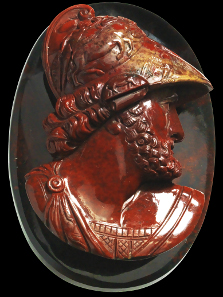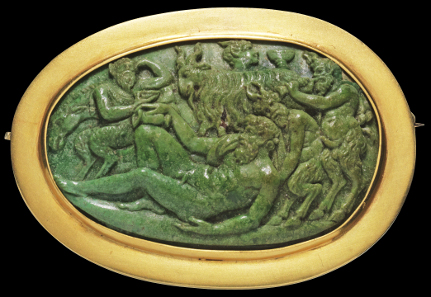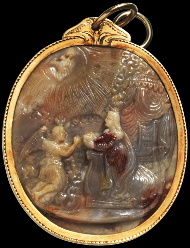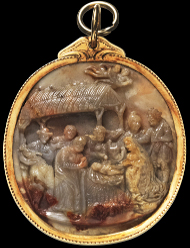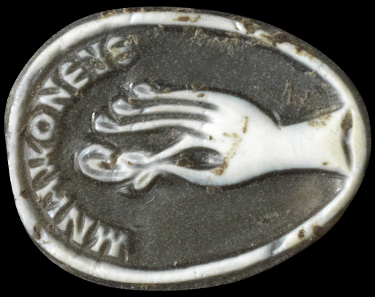24-06-2014 – 25-06-2014
Auction Sale 223: Ancient Jewelry / Gems, Cameos, Seals
Maximum Prices for Cut Gemstones
In 1755/6, the porcelain painter Philipp Daniel Lippert released his famous Dactyliotheca. It contained a selection of 3,149 casts of gems and signet stones that triggered a hitherto unparalleled enthusiasm for cut gemstones amongst erudite people. Admittedly, they all used to collect coins. But from that moment onwards every true and self-respecting collector tried to enrich his collection with ancient gems. Gems became such central a topic that a poet like Lessing felt called to review a popular introduction into gemology with such harsh words that his article went down into world literature as a classic hatchet job. Goethe wrote a treatise on gems in 1823. And everyone complained that there were not enough ancient stones to come by and that no other field witnessed so many modern forgeries as the field of gems.
Today, these skilful imitations and new creations from the Classicistic era are considered artworks in their own right. And they continue to be treated as part of numismatics. Naturally, many coin and medal aficionados, normally admirers of ancient art, showed up at auction sale #223 of Gorny & Mosch’s to place their bid for the marvelous collection of cut gemstones auctioned off by the auction house on 26 June 2014.
1215: Ajax with decorative helmet. Presumably Italy, late 18th cent. 7.5 x 5.5 x 3 cm. Large cameo, bloodstone. Tiny chips at lower edge of bust, excellent state of preservation. Estimate: 7,000,- euros. Hammer price: 18,000,- euros.
After all, a work like the gorgeous head of Ajax with his decorative helmet is in no way inferior to ancient objects. As a matter of fact, the Italian artist who turned the large bloodstone into this jewel at the end of 18th century took an ancient statue group as model. His Ajax is a reflection of the so-called Pasquino Group that illustrates a scene from the Iliad: the hero Ajax tries to recover the corpse of dead Achilles. Hence the price of this unique masterstroke increased from an estimate of 7,000 euros to a hammer price of 18,000 euros.
1178: Dionysian scenery with satyrs lifting a wine-intoxicated Silenus. Cameo, probably malachite, mounted as brooch in modern gold frame, gold mark at the edge. Presumably Italy, 16th cent. 3.9 x 2.5 cm. Intact. Estimate: 5,000,- euros. Hammer price: 10,000,- euros.
Rather modest in comparison appears the price of a cameo made of malachite that was made much earlier, mounted as brooch in the 19th or 20th century. The Italian work from the 16th century depicts a drunken Silenus several satyrs take care of. The marvelous item, once part of the collection of a Russian Prince, had been estimated at 5,000 euros and changed hands for 10,000 euros in the end.
1162: Bust of Silenus with facial features of Socrates. Probably Rome, 2nd half 17th cent. 5.1 x 4.1 x ca. 2.2 cm. Large oval-shaped cameo, layered sardonyx. Intact splendid specimen. Estimate: 6,000 euros. Hammer price: 9,500,- euros.
Almost as much, 9,500 euros, was the price obtained by the relief of a Silenus that protrudes plastically from the background (estimate: 6,000 euros). The piece, fabricated in 17th century Rome, was cut into the precious layered sardonyx that gives the head of the drunken Silenus an incredible degree of liveliness thanks to its colored inclusions. The baroque jewel takes up the old idea that Socrates bore such great a similarity to a Silenus that the two images constitute an intellectual vexatious game. Pure joy of life, combined with the Socratic spirit of enlightenment; that is what this cameo embodied, and his former owner used it to convey his world view.
The antiquity-trained collectors therewith adopted a Roman habit. A gem was not merely a work of art. While an upper-class Roman conveyed his political opinion with the stone inserted into his ring which he used to seal the most important documents with, the works of baroque and classic times mirrored the attitude of their owners.
A drunken Silenus symbolized his owner’s hedonism. An Antinoos as shown on the piece of jewel, framed by pearls, sold under lot #1160 (estimate: 1,800 euros / hammer price: 4,000 euros), had its own secret message that could only be understood by an insider. As stoic the owner of a signet ring with an intaglio of amethyst exhibiting the portrait of Seneca wanted to be seen (estimate: 800 euros / hammer price: 2,400 euros).
1184: Annunciation to the Blessed Virgin Mary / Adoration of the Christ Child. Northern Italy, around 1500. 4.4 x 3.8 x 0.8 cm (without frame). Cameo, agate, cut on both sides, grey-brown. Decorated gold mounting with two hanging loops. Intact. Estimate: 8,000 euros. Hammer price: 26,000,- euros.
In medieval and renaissance times, in contrast, ancient gems and their later imitations were not cherished as worldly adornment but incorporated into reliquaries in order to praise God or be constantly carried around as object of veneration. A two-sided (!) cameo with the Annunciation to the Blessed Virgin Mary or Adoration of the Christ Child, respectively, therefore bear testimony not only to the great artistic skills of its creator but likewise of the great piety its former owner harbored. The unique object became the most expensive item of the entire auction sale with its price of 26,000 euros (estimate: 8,000 euros).
The ancient models to these works of art were available for sale at comparatively modest prices. The connoisseur was given the opportunity to acquire Roman seal rings made of silver at prices that ranged in the lower three-figure regions. Simple gems and cameos usually were available for sums below 1,000 euros.
1100: Cameo with hand and Greek inscription. Roman, 3rd- 4th cent. A. D. H 1.5 cm. Tiny chips missing. Estimate: 4,000,- euros. Hammer price: 6,500,- euros.
Naturally, there were some expensive pieces there, too, like a Roman layered agate that virtually calls for searching for its background story. It depicts a hand that pinches an ear by the earlobe plus the Greek inscription “Remember!” The secret of this item came at a price. Having been estimated at 4,000 euros, it changed hands for as a high a sum as 6,500 euros.
All results can be viewed here.
The next auction sale “Ancient Art” is scheduled for December 2014. Consignments are welcomed until September 2014. The next coin auction will be conducted from 13 to 17 October 2014. Further information is available at Gorny & Mosch, Giessener Münzhandlung, Maximiliansplatz 20, D-80333 Munich, phone +49 / (0)89 / 24 22 643-0, fax +49 / (0)89 / 22 85 513.




